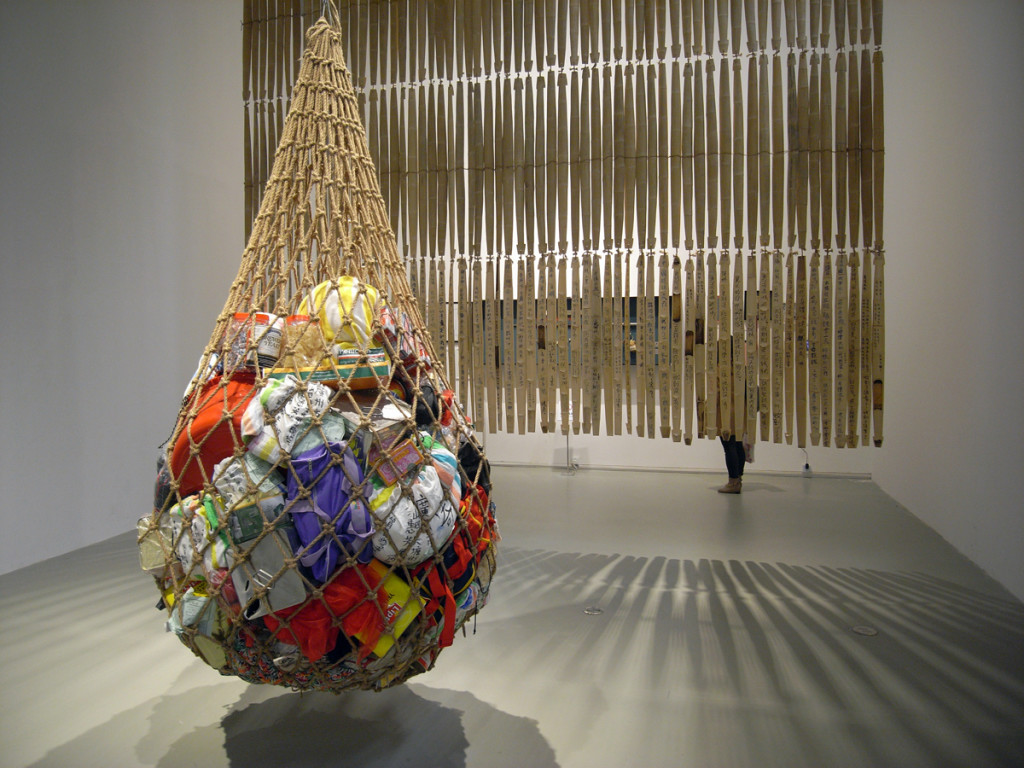第九上海雙年展2012: 黎肖嫻《1906 – 1989 – 2012: 廣州-香港-上海-安吉》
Now that the Shanghai Biennale is getting close to its end (scheduled to finish in the end of March), I would like to conclude my previous posts related to the biennale (Shanghai Biennale 2012, Berlin Pavilion, Sydney Pavilion, Daejeon Pavilion) with one more post, this time about one specific artwork that I enjoyed. It is a subjective selection. The artwork that stood out for me was Linda C.H. Lai’s “1906 – 1989 – 2012: Guangzhou – Hong Kong – Shanghai – Anji”.
Lai’s work took the form of a mixed media installation that consisted of a net with miscellaneous consumer goods suspended from the ceiling, a spatial divider created of bamboo wood slices and a wall with an assemblage of historical documents, videos and objects.
Firstly, I liked the spatial distribution of the work and the way how it changes scale from large to small. The first thing the visitor sees is the large spherical shape suspended from the ceiling. It is an sculptural object in it’s own right, which however changes its meaning with the distance from the viewer (when he gets closer, he can see the materials from which it is constructed) and well as with the time spent with the artwork (after exploring all parts on the installation, the viewer understands the context, which allows for a different reading of the object.) Behind the consumer goods ‘ball’, there is the aforementioned bamboo curtain, with messages written on each of the bamboo strips. This is very much reminiscent of the traditional way of writing/storing text before the invention of paper. It is also reminiscent of the ‘courier’ mode of transporting information written on physical carriers. The last part of the installation mounted on the wall behind the bamboo curtain consists of photos, video clips, historical scales, written documents etc. This part is like an ‘archive’ or a ‘brain’ of the installation, providing detailed information. However even without studying individual artifacts in detail, one can quickly grasp the context which offers the key to the whole installation.
The narrative of the work revolves around the movement of people and goods across borders during different periods within the last hundred years of Chinese history. Letters have been sent to relatives, as well as presents in the form of consumer goods available only at one side of the capitalist/socialist border dividing Hong Kong and Guangdong Province of Mainland China. Without going into details, the work managed to capture the dynamics of twentieth century history of Southern China, from the colonial glory of Shanghai, to the establishment of Hong Kong on a ‘rock’ off the Guangdong coast, to the different ways that Hong Kong and Mainland China took, to the ‘reunification’. More than that, references to bamboo and Anji (a rural area not far from Shanghai with large bamboo forests) serves as a reference to ‘roots’, as well as to ‘literacy’ in the sense of using bamboo-made utensils for writing/storing text. Instead of referencing the grand ideological historical narrative, it references a personal narrative of persons who lived through this turbulent period, showing a slice of their daily concerns and worries as times have passed.
For me personally, the artwork has also been a monument to the desires and connections that stretch across temporary political borders. It reminded me of the division between East and West Germany which I have personally experienced. The sending of letters across the impenetrable border, the scarce visits, the longing for a contact, as well as the longing for consumer goods and cultural products that were scarce on one and abundant on the other side of the border, whose both sides have been inhabited by people of the same kind and of the same roots.
I appreciated how all these reminiscences related to history, geography, personal experience, desire and longing came together in one work. I appreciated the way how the work allowed for a spatial ambulatory ‘reading’ in time. And I appreciated how it was able to address universal human experience even though it referred to a very specific geographical and temporal context.